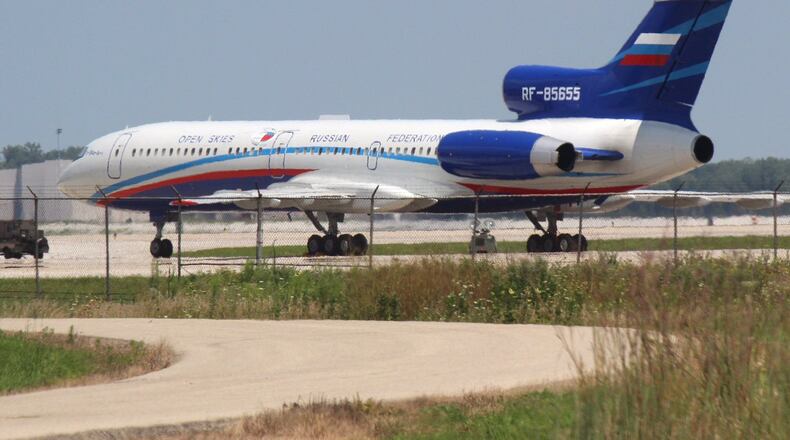U.S. personnel were allowed to be part of the Russian surveillance flight on the pre-determined route, officials have said.
The unarmed observation flights, meant to ensure compliance with arms control treaties, are permitted under the Treaty of the Open Skies. The flights have flown out of Wright-Patterson for years since the agreement was signed by 34 nations.
RELATED: Photos reveal Russian surveillance plane spotted at Wright-Patt
A State Department official confirmed to this newspaper the United States will take “some reasonable and comparable steps in response to Russia’s non-compliance” with the treaty. However, additional details describing those steps were not immediately released.
“We have long had concerns about Russia’s implementation of the Open Skies Treaty,” the official said. “After repeated, unsuccessful attempts to engage Moscow diplomatically, we have elected to take some reasonable and comparable steps in response to Russia’s non-compliance.
“We hope this will change Russia’s calculus and encourage Russia to engage with us about our concerns more constructively,” the State Department official added. “We’re ready to reverse these measures at any time, should Russia come back into compliance with its Open Skies Treaty obligations.”
The Wall Street Journal reported Tuesday that the U.S. has concerns about Russian restrictions on American surveillance flights over the region of Kaliningrad — an area reported to have sophisticated weaponry — and objected to altitude floors over Moscow, among other complaints. The story reported the United States was pondering restrictions on Russian flights over Hawaii and Alaska.
RELATED: Russia spy plane flying out of Wright-Patt
Richard Aboulafia, a senior aerospace analyst with the Virginia-based Teal Group, said the U.S. may be taking the actions for one of two reasons.
“One is that they’ve done a very thorough assessment and they’re balancing what the U.S. is getting out of these flights relative to what they think the Russians are getting out of these flights and they’ve decided it’s not worth it,” he said in a telephone interview Wednesday.
“The other is that they are doing this for reasons of political showmanship, which is very dangerous,” he added. “You don’t want to cut off a valuable resource of intelligence and confidence building just to prove a point to the political base. Hopefully, it’s the first (reason). I don’t know which one it is.”
Steven Pifer, a Brookings Institution non-resident senior fellow and former U.S. diplomat to Russia and Eastern Europe, said U.S. restrictions should be reciprocal to what Russia imposed on the United States.
“I think keeping the treaty makes a lot of sense,” he added. “It’s probably less useful to the U.S. simply because we have surveillance satellites, but the advantages of Open Skies is it allows our allies to do it.”
Gary A. O’Connell, a retired chief scientist at the National Air and Space Intelligence Center at Wright-Patterson, said Russian surveillance flights have originated over the years at Wright-Patt because NASIC processes data collecting from the missions and the agency provides expertise to treaty negotiators about surveillance-gathering capabilities. Nations that signed the treaty are obligated to share imagery with the other countries tied to the agreement in a bid for transparency.
O’Connell said the United States should impose restrictions on Russia because if it does not, it may “push the envelope even more and try to restrict further” where the U.S. may fly under the treaty.
“As one county starts restricting another country’s overflight rights, than that just increases the suspicion and is almost counterproductive,” he said.
RELATED: Son of Cold War U-2 pilot Francis Gary Powers speaks at Air Force museum
U.S. Rep. Mike Turner, R-Dayton and a member of the House Armed Services Committee, expressed concern about the recent Russian flight that flew out of Wright-Patterson.
“Allowing Russian spy planes to fly over and photograph our most sensitive military installations puts our country at risk,” he said in a statement. “Just this summer, a Russian spy plane flew over Wright-Patterson Air Force Base. As a member of the House Armed Services Committee, I have heard repeated, yet unsurprising, testimony confirming Russia’s abuse of the Treaty on Open Skies. I look forward to the Administration stopping this practice.”
According to the Russia Today website, a Kremlin spokesman has urged treaty members to stick to terms of the agreement and raise concerns through the treaty provisions.
More than 1,200 Open Skies flights have been recorded over the years, a Defense Threat Reduction Agency spokesman has said.
Unmatched coverage
Count on us to continue our in-depth coverage of Wright-Patterson Air Force, work made possible through your subscription.
About the Author
